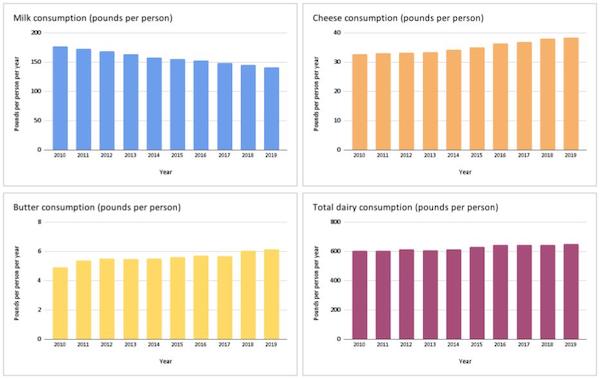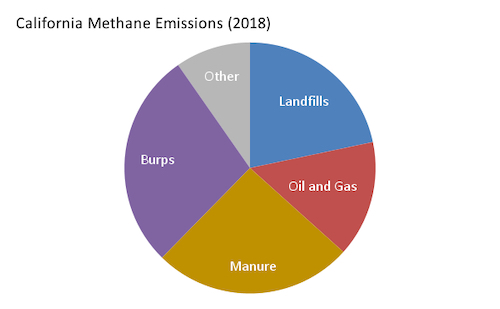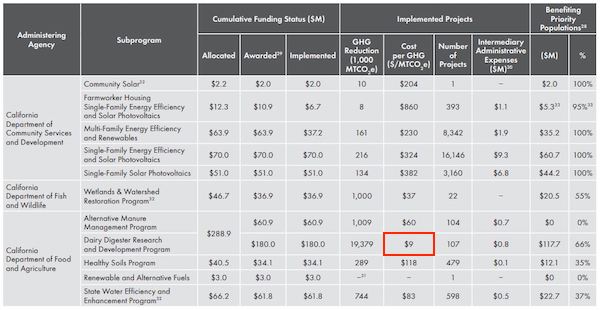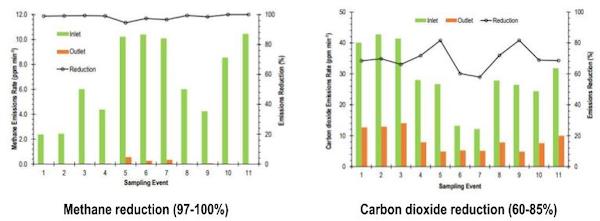
Do we have to choose between dairy and a livable planet? (Photo credit: UC Davis)
I’ve been meaning to do a blog post on alternative dairy items, but I’m stalling because I’m just not that excited about trying them. Every now and then I’ll buy a few dairy-free foods in the hopes that we’ll give them a shot, but they stand idly by in our fridge until one of us checks an expiration date. Even the peach “almond milk yogurt” stands unopened right now, and that sounds pretty tasty, right? I am pretty sure the dried pseudo-cheese yeast flakes, or whatever that stuff is, would go unopened.
Our household has a dairy problem. And it’s not just us. Even though non-dairy milk is growing strong in the US, with per capita dairy milk consumption dropping 20% in the last ten years, cheese consumption has gone up 17% and butter 25%. When you look at overall dairy consumption on a milk-fat basis, it has gone up 8% since 2010. Yikes.

Milk consumption in the United States (blue) decreased 20% from 2010 to 2019, but overall dairy (maroon) went up 8% because consumption of high-fat cheese (orange) and butter (yellow) rose by 17% and 25%, respectively. (Source: USDA, 2020)
Maybe California lawmakers understood this when they set a goal in 2016 (SB 1383) to reduce methane emissions by 40% from 2013 levels by 2030. About one quarter of those emissions come from manure management and another quarter from “enteric fermentation” (burps).

Emissions from manure management and enteric fermentation (burps) compose more than half of all California’s methane emissions. Around 80% of those are from dairy farms. (Source: CARB, 2019).
California is putting its money where its goals are and has been investing hundreds of millions of dollars on programs to reduce methane. Farms are making headway. In fact, by some measures the improvements in greenhouse gas reductions on farms are some of the best bang for the buck that California is getting from its efforts to reduce greenhouse gases. Check out the table on pages 15-20 of the annual report on California’s climate investments of Cap-and-Trade funds. It shows the cost for removing a million tons of CO2e for each of the programs they have funded. Anaerobic digesters come out a big winner, costing only $9/MT CO2e. The digesters are being widely deployed, in part because farmers can reap carbon credits from reducing their emissions, and because they can use or sell the energy that is produced.

Manure management programs reduce emissions at a fairly low cost. To date, they have achieved 29% of all program reductions but used only 2.2% of the funds. (Source: CARB, 2021).
Thomas Perkins is the VP of Operations at CalBio, which designs and installs manure digesters at dairy farms. A digester covers a farm’s open waste lagoon to capture the emitted biogas, which is essentially methane. The gas can then be burned to generate electricity or to power vehicles. When asked during a recent CEC AgTech event how farmers respond to their sales pitch, he replied: “Dairies are eager to exercise our technology, they’re in a hurry for our digesters to be built quicker, sooner than later… (We hear) ‘Let’s get this thing started, and let’s start generating these revenues…’. The dairymen are out there ready for this improvement in greenhouse gas mitigation.” (1)
Biogas is virtually identical to methane and natural gas. It is subject to leaking from the digester or pipes just like natural gas, and it will produce carbon dioxide when burned, just like natural gas. Farms that use digesters need access to gas pipelines to export any methane that is produced. While many gas utilities are eager to incorporate this “renewable gas” for residential heating, it is relatively expensive and limited in supply, plus creates air pollution and emissions when leaked or burned. It is best used for sectors that are difficult to electrify, such as some industrial uses.
Because of these problems with biogas, California has also asked farms to reduce the amount of methane they generate by evaluating dry manure management techniques. When manure decomposes aerobically rather than anaerobically (in wet lagoons), much less methane is emitted. Composting waste is one way to do this. One innovative company, BioFiltro, uses worms to treat wastewater before it enters the lagoons (aka “vermifiltration”). Waste water is fed onto a deep bed of wood chips layered on top of crushed rock. As the fluid slowly seeps down through the 5-foot thick bed, worms living in the wood chip layer feed on the organics, removing 70-99% of contaminants from the liquid waste in just 4 hours, per BioFiltro’s VP of Marketing and Sales Mai Ann Healy. As a result, few organics are left to decompose in the lagoon.

When BioFiltro’s vermifiltration step is inserted before wastewater enters a lagoon, water quality greatly improves. The filtered water releases less methane and carbon dioxide, and is far more useful and easier to manage for the farms. (Source: EPIC AgTech Virtual Tour, 2021)
The higher quality water releases fewer emissions from the lagoon, and can be used for more purposes, such as cleaning out stalls or watering crops. The odor is also greatly reduced. Farms deploying this system can earn revenue from carbon credits, plus they can use or sell the worm casings (poop), which make for a great soil amendment. (2)

Greenhouse gas emissions from a wastewater lagoon are greatly reduced after being filtered through BioFiltro’s vermiculture system. (Source: Washington State University and BioFiltro, 2020)
While most dairy emissions stem from manure management, a smaller but still significant amount result from the cows’ digestion (fermentation) process. Researchers at UC Davis and elsewhere are investigating feed additives that can reduce the amount of methane that the cows produce. A small amount of red seaweed, for example, can inhibit the last stage of fermentation in the cow’s rumen so that they exhale hydrogen in place of some of the methane. Early experiments show a reduction in exhaled emissions of 33 to 80%, depending on what else the cows are eating. Seaweed can also improve the efficiency by which cows convert food to energy; they may need up to 20% less food on a seaweed-enhanced diet.
California’s dairy farms are under considerable pressure. Consumers want lower-impact dairy products, and the state aggressively regulates water quality, air quality, and animal welfare as well as climate emissions. On top of this, California has high costs for labor, energy, and permitting. Many smaller farms have struggled to make ends meet, leading to consolidation across the industry. Yet California is by far the largest dairy-producing state, supplying about 20% of the country’s milk, and over the years the dairies have become some of the greenest in the world. A UC Davis report estimates that California dairies have reduced emissions by 45% per unit of milk over the last 50 years. Professor Ermias Kebreab adds that others should take notice. “Attaining California’s level of production efficiency in all global dairy production regions could reduce total global GHG emissions by as much as 1.73 percent.”
These improvements don’t zero out the emissions from the cheese and other dairy I consume. I should still try out that almond-milk yogurt sitting in the fridge. But I do take some comfort in knowing that California’s dairy farmers are working closely with industry and academia to reduce their climate footprint and make this part of our food supply more sustainable. Straus Family Creamery founder and CEO Albert Straus says that he feeds the cows with an electric truck that is powered by the cows’ own digested waste. That is pretty neat. Moreover, it’s still early days for many of these technologies. Another presenter at the CEC’s AgTech event, CEO Sarah Richardson of MicroByre, talked about the potential to create designer microbes that transform waste into useful products beyond fertilizer, for example succinic acid or acrylic acid. She calls this “upcycling waste”. To what extent can we turn the dairy farmers’ biggest headache, the vast amounts of manure the cows generate on a daily basis, into a valuable new market for the dairies, while also reducing greenhouse gases and pollution? It’s a really interesting time to be a dairy farmer in California!
Notes and References
1. You won’t be surprised to learn that one of the biggest sources of delay is permitting. Managing large volumes of wastewater is no easy matter in California.
2. A dairy farmer discusses his experience with vermifiltration in this short video.
Current Climate Data (April 2021)
Global impacts, US impacts, CO2 metric, Climate dashboard (updated annually)
Comment Guidelines
I hope that your contributions will be an important part of this blog. To keep the discussion productive, please adhere to these guidelines or your comment may be moderated:
- Avoid disrespectful, disparaging, snide, angry, or ad hominem comments.
- Stay fact-based and refer to reputable sources.
- Stay on topic.
- In general, maintain this as a welcoming space for all readers.



